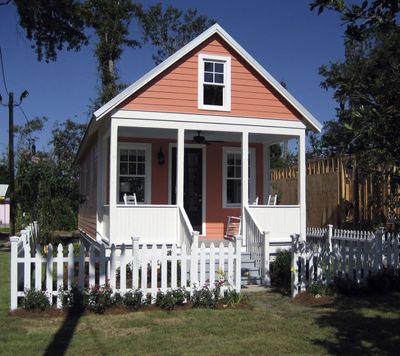Living small more popular as home values fall, energy costs rise

Tiny houses are going mainstream.
Just look at the Katrina Cottage, originally designed by architects Andres Duany and Marianne Cusato as a dignified alternative to the FEMA trailer for flood-ravaged New Orleans.
The tiny charmer with a pitched roof, nostalgic front porch and 300 to 1,800 square feet is becoming popular elsewhere; Lowe’s home stores sell the blueprints and materials.
The cottages are being used as affordable housing, guesthouses and vacation cottages.
It’s part of a larger trend toward living small.
The average size of the American home expanded from 983 square feet in 1950 to 2,340 square feet in 2004, up 140 percent. This boom was largely driven by a belief that living big meant living well, and that real estate was a great investment so the bigger the house the better the investment.
The recession is one thing killing that notion. Millions of foreclosures have meant “people have lost a ton of equity,” says Boyce Thompson, editorial director of Builder magazine.
Add in high unemployment and energy costs, and no wonder small might seem better.
According to the American Institute of Architects, 57 percent of architecture firms reported a decrease in the square footage of homes they designed last year.
Another factor is people’s desire to live more ecologically, less wastefully.
And there are demographic changes. Thompson points out that one-third of American home buyers are now single; people are marrying later, and many don’t want to wait until marriage to invest in a house.
Moreover, as Americans live longer, many widows and widowers are downsizing to small homes.
And with elderly parents and grown children returning home, there are more multigenerational families, increasing the demand “for small auxiliary buildings,” Cusato says.
Tiny dwellings allow generations of a family to live side-by-side with privacy.
How small is tiny?
Some people don’t just want small; they want minuscule.
Mimi Zeiger, author of “Tiny Houses” (Rizzoli International, 2009) and the new “Micro-Green” (Rizzoli International, March 2011), defines tiny houses as around 1,000 square feet, although “some enthusiasts cap them at the 300- to 400-square-foot range,” she says.
In “Tiny Houses,” Zeiger presents three dozen international examples, including some in the United States. She believes that America’s abundance of land and materials has traditionally made us less conscious of conservation than people elsewhere are, but that is changing.
Cusato credits Sarah Susanka’s book “The Not So Big House” (Taunton), first published in 1998 and expanded in 2009, with starting a movement to change the way builders work.
“People started saying they wanted their houses to be smaller, but better,” Cusato says.
Susanka, who considers a tiny house to be one measuring no more than 500 square feet, once lived in an 8- by 12-foot flatbed trailer truck.
“There has always been a fascination with tiny houses and an underground interest in them that surfaces when the economy goes down,” Susanka says.
The best solution for housing in America, she believes, will be in the middle ground: 1,500 to 2,500 square feet.
“The gift of the recession will be that Americans will believe that bigger is not better,” she says.
Making a tiny space livable
“You have to be very disciplined to live in a tiny space,” Susanka says.
Adds Zeiger, who lives in a small studio apartment in Brooklyn, N.Y.: “The most important thing that makes a tiny house livable is efficient space planning and clever storage. Like on a ship, things need to have dual purposes.
“You also need good light and air, so that the space isn’t claustrophobic or hut-like, but is a space you want to spend time in.”
Her table, for example, serves as both kitchen table and office desk.
Cusato agrees that light is essential in a small space. She recommends “windows on multiple walls in a room, two at a minimum – three or four are ideal. Tall ceilings – 9 feet in a small space feels great.
“When living in a tiny house, lots of storage is essential. Nothing makes the walls close in faster than clutter.”
Proximity to a public space is fundamental, she believes, and recommends that porches or terraces connect to street life or a garden.
When her apartment starts to feel cramped, Zeiger goes to a neighborhood coffee shop. And since she doesn’t have space for a lot of bookshelves, she takes full advantage of the public library.
Says Cusato: “The house does not need to be the size of an entire town if it is connected to a town.”